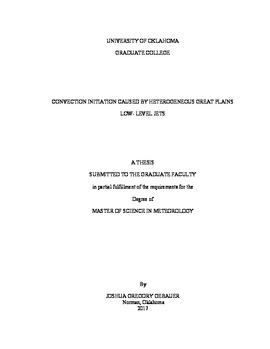| dc.description.abstract | Nocturnal convection is a common feature of the Great Plains region. Forecasting this convection, however, is challenging, as the processes leading up to convection initiation (CI) can be subtle. It has been discussed in literature that the nocturnal low-level jet (LLJ) plays an important role in nocturnal CI over the Great Plains. The LLJ provides both dynamic and thermodynamic support for convection, particularly north of the jet wind speed maximum. Convection that initiates outside of this region is harder to diagnose, as the forcing is not as obvious. One of the objectives of PECAN was to better understand the role of the LLJ in CI. On three nights during the field campaign, north-south lines of CI occurred on the eastern side of the LLJ. The lines of CI were parallel to the LLJ axis and the forcing for the CI was unknown. These nights were analyzed using PECAN observations, numerical weather prediction models, and established analytical frameworks to identify the cause of the CI.
A common feature on all three nights was a horizontally heterogeneous LLJ with wind direction veering with height. The structure of these LLJs resulted in elevated convergence at the top, eastern region of the jets. The veering with height wind direction also resulted in eastward moisture advection at the top of the LLJ. Along with the moisture advection, Rapid Refresh (RAP) model cross-sections and Weather Research and Forecasting (WRF) model back-trajectories indicate that subtle lift was occurring within the LLJ. This subtle lift caused the air to become saturated as it was advected eastward, which further increased the instability. The combined analysis of observations and model output indicate that convergence, moisture advection, and subtle long term lift initiated the convection. The horizontal heterogeneity of the LLJ can be explained by buoyancy gradients over the sloped terrain, which created a northerly thermal wind and also an east-west gradient in the geostrophic wind. As a result of the horizontal gradient in the geostrophic wind and the typical soil moisture gradient across Kansas, the daytime boundary layer was deeper in western Kansas than in eastern Kansas, which caused the vertical structure of the LLJ to vary across the slope. This ultimately led to the convergence later in the night.
Since the unique structure of the LLJ on these nights was critical for initiation the convection, a planetary boundary layer (PBL) scheme sensitivity test was conducted using WRF to determine if there was an ideal PBL scheme for modeling these CI events. It was found that the CI was highly sensitive to the PBL scheme. The Yonsei University (YSU) scheme was determined to be the best for modeling these north-south lines of CI, but all PBL schemes, including YSU, produced inaccuracies in the LLJ structure. The westerly wind maximum at the top of the LLJ tended to be stronger and higher than what was observed, and significant errors in moisture were often found in the model. This indicates that models may struggle with consistent, accurate forecasting of these north-south lines of CI. Therefore, a conceptual model for north-south lines of CI was created to aid in forecasting these events. | en_US |
